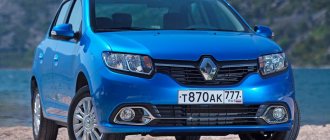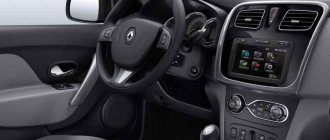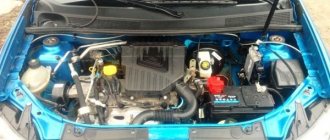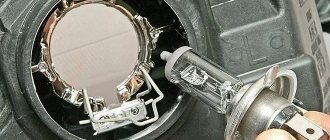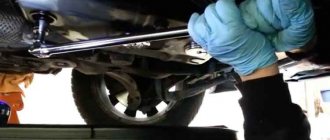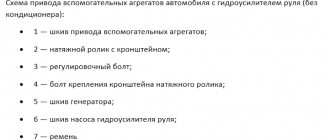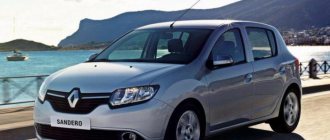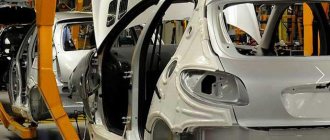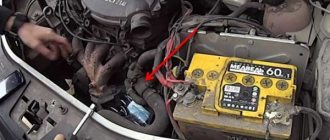The indisputable advantage of Renault Logan over its competitors, produced by both domestic and foreign manufacturers, is the low price not only for all configurations present in the model range, but also for spare parts for them.
One of the simplest options in terms of configuration is the 1.4 modification, which is as economical as possible.
The technical characteristics of this version of Logan, as well as its capabilities, are described in this article.
What are the weight and dimensions of the car?
For a budget model, the most important parameters are its low consumer cost and significant efficiency. This result became achievable due to:
- the use of cheap materials in the interior;
- partial galvanization of the body, affecting only those panels that are most vulnerable to exposure to the external environment;
- availability of modest configurations in the range.
- improved technical characteristics.
The engineers managed to create the Renault Logan as the most leading model for its class, despite the modest dimensions of the body.
If we touch on the length of the car, then according to the stated data it is 4288 mm.
Renault Duster low beam lamp replacement
Firmware Renault Duster 2.0
Autostart for Renault Duster
The width of the model is also not a strong point - only 1740 mm.
The height of the Renault Logan is sufficient to comfortably accommodate tall passengers and reaches 1534 mm. How much does the model we are considering weigh? According to official data, this parameter is 1124 kg for an empty car.
By using the MacPherson system in the front suspension and a simple spring-loaded torsion beam at the rear, the manufacturer endowed the Renault Logan with a significant load capacity of approximately 0.5 tons. Now the total weight of the version reaches 1535 kg.
Ground clearance has become a strong point of the modification. Thanks to 155 mm of clearance, the car can overcome areas of light off-road that are unattainable for most foreign passenger cars.
Renault Logan engine, characteristics of Renault Logan engines
The Renault Logan engine today determines not only the overall price of a budget car, but also fuel consumption and the dynamics of a budget sedan. Now we will tell you in detail about the Logan engines of the first and second generation of the car. We’ll pay special attention to engines for the Russian market, and we’ll also talk a little about the versions of power units that are offered in other markets.
So, the first generation of Renault Logan appeared in our country in 2005 with two gasoline engines with an 8-valve timing mechanism and a timing belt. These are 1.4 MPi and 1.6 MPi engines. The engines themselves were closest relatives, since they were structurally similar, the difference was only in the working volume.
The power supply system is distributed fuel injection (Euro-2 toxicity standards). The power of the 1.4-liter engine was 75 hp, the 1.6 engine at Euro-2 produced up to 87 hp. However, with an increase in the environmental standard to Euro-4, the power decreased to 82-83 horsepower. The 1.4 MPi engine had the factory index K7J; the more powerful 1.6-liter Logan engine model received the index K7M.
Structurally, both engines had a cast iron block, an aluminum cylinder head, one camshaft, and a timing belt. As for the valve mechanism, there were no hydraulic compensators to automatically adjust the thermal clearance, that is, the valve clearance had to be periodically adjusted manually.
- Equipment
- Specifications
Specifications
| Body | |
| Body type | sedan |
| Number of seats | 5 |
| Number of doors | 4 |
| Transmission | |
| Drive unit | front |
| Transmission | mechanical |
| Number of gears | 5 |
| Engine | |
| Volume | 1.6 (1598 cm 3) |
| engine's type | petrol |
| Engine location | front transverse |
| Injection type | distributed injection |
| Number of cylinders | 4 |
| Valves per cylinder | 2 |
| Rated power | 62 kW / 84 hp (at 5500 rpm) |
| Max. torque | 124 Nm (at 3000 rpm) |
| Gas distribution mechanism | DOHC |
| Cylinder arrangement | in-line |
| Cylinder diameter | 79 mm |
| Piston stroke | 80 mm |
| Compression ratio | 9.5 |
| Wheels | |
| Front tire | 185 / 65 / R15 |
| Rear tire | 185 / 65 / R15 |
| Spare wheel | full size |
| Front discs | 15″ |
| Rear discs | 15″ |
| Dimensions | |
| Height (mm) | 1534 |
| Length (mm) | 4288 |
| Width (mm) | 1740 |
| Ground clearance (mm) | 155 |
| Wheelbase (mm) | 2630 |
| Front wheel track (mm) | 1481 |
| Rear wheel track (mm) | 1470 |
| Turning diameter (meters) | 10,5 |
| Minimum trunk volume (liters) | 510 |
| Maximum trunk volume (liters) | 510 |
| Weight | |
| Curb weight (kg) | 980 |
| Gross authorized weight (kg) | 1540 |
| Dynamic characteristics | |
| Aerodynamic drag coefficient | 0,36 |
| Maximum speed | 175 |
| Acceleration time to 100 km/h | 11,5 |
| Fuel consumption | |
| Urban cycle (l/100 km) | 10 |
| Country cycle | 5,9 |
| Mixed cycle | 7,3 |
| Fuel tank capacity | 50 |
| Recommended fuel type | AI-95 |
| Price | 402,000 rub. |
The prices indicated for this package are provided by official sources and are recommended retail prices. These prices do not take into account special offers directly from sellers (benefits on payment, insurance, etc.).
Currently reading: Renault Logan suspension: device, features and reviews
The basic package may differ from those offered by the dealer in terms of the availability of additional options and price.
Models closest in price and parameters
| Manufacturer/model | price, rub. |
| Lifan Breez Sedan 1.3 MPI (65 kW/89 hp) 4×2 manual transmission BX | 334 900 |
| Renault Logan 1.4 (55 kW/75 hp) manual transmission Authentique | 349 000 |
| FAW V5 1.5 (75 kW/102 hp) manual transmission Comfort | 412 000 |
| Citroen C-Elysee 1.2 VTi (53 kW/72 hp) Dynamique manual transmission | 455 900 |
| Peugeot 301 1.2 VTi (53 kW/72 hp) manual transmission Access | 455 900 |
- Show similar in price
- Show analogues by parameters
When searching for analogues, the similarity of the following parameters is used:
- body type,
- type of drive,
- gearbox type,
- engine capacity,
- engine power,
- car dimensions,
- car weight.
This unit has the factory index K7J, is petrol and is the first in the Renault Logan line. The remaining 1.6-liter power units are only further improvements in the design of this engine by increasing the piston stroke and engine displacement. This unit is produced in Romania at the Dacia plant and is a logical continuation, in its design, of the line of engines of the French manufacturer of the 80s. By its design, it is a classic engine for its segment:
- the power unit has 4 cylinders and 8 valves, that is, 2 valves per cylinder, the cylinder arrangement is vertical, in-line;
- The timing drive is carried out from a toothed belt.
The declared resource of the unit is 200,000 kilometers, but many motorists easily managed to overcome this mark. There are known cases of reaching a mileage of 400,000 kilometers without major repairs.
This is due to a torque of only 115 Newton meters, due to the rather archaic design of the 1.4 unit. However, the low dynamics are compensated by moderate fuel consumption for this modification and its model year and good indicators of engine reliability and service life.
Motors and their dynamic capabilities
What engine modifications are available for Renault Logan? They are all similar in their transverse location under the hood. The design of the blocks is also the same - 4-cylinder. All engine options are devoid of turbocharging, but are equipped with a modern distributed injection system.
Technical characteristics are up to par. The most modest engine is the 1.4 and 8-valve “four”, developing 75 hp. With. The engine is capable of digesting two types of gasoline: 92 and 95.
Due to the small volume, the manufacturer managed to achieve unprecedentedly low fuel consumption. The entire range of engines available for the compact Renault Logan model boasts this feature.
In suburban mode, this engine can achieve a consumption of 5.5 liters per “hundred” kilometers. If you drive in mixed mode, this figure increases to 6.8 liters. The urban cycle is characterized by a consumption of 9.2 liters.
The dynamic capabilities of this version are modest, since the first 100 km/h is “exchanged” in 13 seconds.
The maximum speed that the weakest variation of the model can reach is a modest 162 km/h.
The maximum torque generated by the engine will not please “hot” owners, since there is no possibility of sharp starts or responsive downhill climbs. According to the manufacturer's specifications, the torque is 112 Newtons.
Review of Renault Logan 1.4 (2009)
Renault Logan 2009
Engine 1.4 75 hp
Expression package:
- 1 airbag
- Air conditioner
- Power steering
- Window lifters on oars
- central locking
- Rear fog lights
I’ll say right away that I really like the car, I got it sooooo cheap and I don’t regret it 100%. I bought it for 215 thousand rubles. Not broken or painted. 1 owner. Serviced at the dealer. Service book. Original mileage 52,000 km. The car is always in plain sight (bought from friends).
When I registered, some outbid people approached me :D. It's a funny sight. It was raining and it was boring (we were standing there talking to a guy). They say - are you selling? I (to laugh for fun) - yes, I’m selling. Why are you selling it? I don’t know, I’m a sucker, guys, I don’t know the prices... they say - yes, yours is crooked... (I was hooked very strongly and deeply). I say - yes, the engine is knocking, the Khan’s suspension and three people have already died in it (I said in a serious voice). The reseller immediately calmed down and said, okay, you’re kidding... I was the first to start. They say how much? I don’t know... (they want to hear from me first). The most interesting part begins: they take a thickness gauge out of their pocket) ) ) and measure it. Free diagnostics from the “Main Road”)) The paint is original everywhere, there’s nothing to complain about... Will 200 thousand rubles suit you? NO! How much? A lot of. Will 250 work? NO! How much? 300! AND LEAVED)))
I have long wanted to create a topic about this, there are many questions and practically no answers, now I will answer them))) There are many different kinds of questions, but they are all the same)))
- Did you buy Logan? Come on? What are you, a pensioner? You're only 22 years old)))
- What, is Logan better than HYUNDAI? )))
- Yes, he's as scary as my life

- Yes, for that kind of money I would buy it... They wouldn’t buy it for that kind of money)))
- Do you taxi? :DDD
- But he’s not going...
- Lohan.
And so on )
In general, let's start) I won't answer, I'll just compare, and then decide for yourself)
1. Engine
I accelerated Logan to 190 from a hill along the M4 Don highway. Don't believe me? https://www.drive2.ru/cars/renault/logan/logan/ul1ra/journal/?sort=asc Logan: Logan 1.4 eight-valve engine, in the city it’s enough... at 40 km/h you can already drive in 4- 1st gear... pulls confidently from 2nd gear. An 8 valve is what you need in the city. On the lantra, I slowed down in front of the policeman and put the second gear on and waited until the revolutions exceeded 2000, and then it would move more or less... (this made it go stupid, because the revolutions were less than 2000). On the Logan, the situation is the opposite: it pulls confidently from almost 1000 rpm, and in 2nd gear, I was even surprised, I remembered my 8, how it ran better at low revs. As for the engine power, if you don’t drive, then 1.4 is enough (I don’t need more), in the city it accelerates to 80 quickly, on the highway I don’t drive more than 120, the Lantra has the same modes, but the Lantra had a huge power reserve for 1.6, even loaded uphill, even downhill))) The engine was ideal for its weight. On Logan the situation is reversed. I’m driving up a hill like this (I’m used to it on the lantra: I gave a little gas, went and picked up speed up the hill, but here in general))) And then I press (even if I’m alone in the cabin) - it doesn’t go up the hill, it slows down so that it picks up speed up the hill you need to depress at least half the gas pedal, 75 horses after all, if you always press on the gas (which will increase consumption), then you can be the king of the hill on the highway, the engine on the Logan is balanced, not fast and not slow... I like it... at low speeds ... works like a diesel)))
I won’t rate the engines, if I had a 16-valve on my Logan, I would compare)
2. Box
The lantra gearbox was ideal, if you shift at rpm above 3500, they fly like a glove, a box with long gears, 1st - 55km, 2nd - 100km, 3rd - 140km, 4th - 170, 5th - 200. At 60 km/h in You can already go on the 5th hour. On the Logan, the gears are shorter and the gearbox itself is a little different, you hold the slide itself in your hand like a pistol, which was done in the lantra with 2 fingers) Although it’s a matter of habit)) I’m writing some kind of garbage.
Lantra 1-0 Logan
3. Suspension
Here's the most interesting part. Have you driven any Peugeot Boxer (minibus)? So imagine, the suspension is the same energy-intensive, only on a passenger car) - Logan. The suspension is simply phenomenal, it swallows everything, there were even such moments: there was a hole along a country road, now there is no bumper left, the gurgle was swallowed))) And there is no hole))) Small bumps, medium holes swallows... but there is also the other side of the coin: on large wavy In sections of asphalt, it jerks, and a lot, this was not the case with the lantra (it smoothed them out), but the Logan here, alas, jerks. But the lantra did not eat up all the small bumps (it worked off each of them), it got a little onto the body. And Logan handles these bumps somewhere there, under the bottom... At first I thought, what kind of vaunted suspension is there? And now I understand: you need to ride it once to understand what’s what, it’s amazing))
I couldn't be happier, honestly. Lantra is designed for good asphalt, and Logan for bad roads)
Lantra 1-1 Logan
4. Cost-effective
This is where it gets controversial. You may not believe me, I am such a storyteller that I will blatantly lie about the efficiency of both cars. Either I come across such people, or I’m such a driver... But I know how to drive economically))) Judge for yourself: I filled up with BP on a lantra under the neck (95), the consumption at 100-110 km was 4.5-5.5 liters))) And on Logan at a speed of 120 and above refueled with 95 at Lukoil, upon arrival in Voronezh I refueled, the consumption turned out to be 6.6))) This was in a hurry, and when I was driving back, I set myself a goal: to throw up and check the efficiency of the 1.4 engine. I was throwing up at 80-100 km per hour... I haven’t refueled yet, but I’ve already driven 780 km... and I still have 4 sticks left, that is, 6 that went out on top) Logan drivers will understand. I've calculated roughly so far, but not completely... consumption 3.8))) Gasoline 95th ECTO))) A lot? ))) Now I will always feel sick like this)))
Lantra 1-2 Logan
5. Trunk
500 liters versus 390 for the Lantra - everything is clear here, again, in both cars the trunk hinges remove the useful volume.
Lantra 1-3 Logan
6. Salon
Logan's salon: huge, tall, cheap. Stove TASHKENT, there are 4 airflow modes: 1. hot, 2. very hot, 3, and the 4th HARD))) It’s much colder in the lantra. There is more space in the Logan's cabin than in the Lantra, even though it is a class lower. The finishing materials in the Lantra are of high quality, it’s a foreign car from the 90s))) Everything in the Logan is cheap and cheerful, and you don’t need anything else. This is the budget. But when opening the doors in the rain or lowering the windows to smoke, you are not afraid of spilling something in the logan, as if you opened the door (wooden), and in the lantra you are afraid of flooding the electrics (window lifters + lock). Sitting behind the wheel of a Lantra is something, after it I only feel normal in an Opel Omega B or BMW e38) Everything else is not mine. The Logan has a stool-like seating position, as if you were sitting on a chair, which is why my legs hurt after a day of travel (maybe because of this or not, level 3 flat feet, that doesn’t matter...), the Lantra has a huge number of driver adjustments, about 7 of them... in height, inclination + lumbar support. The Logan doesn't even have lumbar support. But my back doesn't get tired.
Lantra 2-4 Logan
7. Availability of spare parts and their cost
If for Lantra you basically need to look for auto body parts at salvage yards and so on, and not all spare parts are in stock, then for Logan there are a dime a dozen, full of broken ones, full of disassembly parts, you can’t go into any store - everything is in stock and even lies on the shelves, I’m very pleased with the HUGE number of duplicates (non-original) and at very cheap prices.
Lantra 2-5 Logan
8. Adaptation to Russian conditions
Logan is taller, and his stove blows, God forbid), and the suspension swallows better. Lantra is low and cold. How did the Koreans know that it would get to Russia) The suspension is not for our roads... hard (mostly)
9.Management
Logan turns into turns as if on rails, there is less roll... BUT it has worse aerodynamics than the Lantra. Logan has a very heavy steering wheel. Although the Lantra had a slightly lighter steering wheel, it was very informative, no emptiness.
Lantra 2-6 Logan
Total: 2-6 In favor of Logan!
Lantra is good in its own way! An excellent balanced car for good roads, despite the fact that the car is 16 years old, it has served me faithfully... It earns back every ruble invested in it with honor. And finally, I answer why I chose Logan and changed my lantra, which did not require investment. Firstly, the Lantra is already 17 years old, I drove it for almost 4 years, covered 70,000 km, the car was so boring, it became so boring that I wanted some other car. It got to the point where you sit in the Lantra and it doesn’t evoke any emotions at all, you just sit down, start it up and drive off. BORING, nothing breaks... I chose Logan because I found it at a very low price, I know the history of the car, no crime. And most importantly, he was sold by friends; Logan is reliable and unpretentious. Huge, spacious, cheap to maintain, in great demand on the secondary market, where consumables are sold everywhere, in a word, a people's car and I don't care what it looks like, I really like it: I like how it behaves on the road; I like the design; I don’t regret buying it and he was lucky that I became his owner)))
- The most significant jamb! I'm going with a girl (I met about 15 minutes ago :D). Night, lantern. Opel, driving slowly in front, I sharply overtake it in 2nd. Here the dynamics appeared unreal: DDD Gazulka took a bite, I heard Logan's cutoff for the first time. I think Hana(((. The girl asks: what are you going to do? I say repair. Opening the hood, I realize that I’m a complete sucker, not knowing where everything is. Thanks to logic. I’m looking for the cable that goes from the passenger compartment to the engine. I found it, I touched it, lifted the pedal into place. I started it, the speed was even)) Although I looked during the day. Everything is on the fastenings... why did I bite before the cutoff, I don’t know)))
- Sometimes the speedometer needle will jump, let's say you're going 110, and it will drop sharply to 100, then back to 110))) Miracles)))
- The door locks and trunk locks worked with difficulty at first... I lubricated them with silicone) Like clockwork)
- Sometimes the passenger seat creaks (springs, in my opinion). Very rarely, mostly on bad roads.
- Small rearview mirrors...
- There is no handle to close the trunk from the inside (which is very inconvenient)
After the purchase I thought a lot about whether or not to go to the OD for service! I decided not to go (and then you’ll understand why)
I bought consumables:
- Valvoline Synpower 5w40 oil - 1610 rub.
- Renault oil filter - 160 rubles.
- Air filter Swag - 190 rub.
- Mitwell carbon cabin filter - 260 rub.
- Contitech timing belt - 320 rub.
- Contitech belt (gur conder gene) - 250 rub.
- Bosch spark plugs - 99 RUR/pcs.
- Water pump (pump) SWAG - 1000 rub.
Are French Russians expensive? 
What I've done:
- Changed the air filter (it was dirty).
- Then I cleaned the throttle body with carburetor cleaner.
- I unscrewed the spark plugs (they were fine) and did not change them.
- The timing belt (in excellent condition) was not changed.
- The attachment belt was all cracked...replaced with a new one.
- I changed the engine oil (I decided to move away from ELF, which Renault so readily advertises).
And now the most interesting part:
When they changed the oil, the oil drained out, then they blew out the air from above with a compressor... every drop of oil poured out. And they began to unscrew the oil filter. Hand first. It won’t unscrew... I had to break it with a crowbar. They broke it with a crowbar, but it just won’t unscrew. I had to hit the filter at an angle with a crowbar to get it unscrewed, but it unscrewed after 1.5 hours. Just don’t need to tell us now that there are special keys... we used them... even 2 times... Verdict:
- The filter is coked.
- Never unscrewed.
- It's factory priced.
- Everything is in the service book.
- They wiped it down along the way and it shines like new)
So, guys, if you take your indestructible Logans for maintenance, be sure to be present in the repair area... they won’t let you in? take it higher:
- OD management
- OD hotline
Good luck to everyone on the roads.
Let's sum it up
The 1.4 and 75-horsepower Renault Logan is not suitable for a dynamic drive. In return, the car will be able to please the practical owner with phenomenal efficiency, smooth running and unprecedented low cost of maintenance and repair; the car has excellent technical characteristics. It is these consumer qualities of cars that are especially valued by the majority of domestic enthusiasts. In view of this, this economical version of the Renault Logan model is one of the most popular vehicles in the domestic automotive market.
Design features and specifications of the internal combustion engine
Engine design K7J (manufacturer Automobile Dacia, Romania) 1.4 l/75 hp. inherited from fairly old Renault Corporation engines developed in the 80s (ExJ series) and therefore looks somewhat archaic: there is an unusual chain drive for the oil pump, used on units with lower camshafts, and ancient timing rocker arms.
The remaining solutions of the 1.4 engine are standard and no different from other four-stroke 4-cylinder single-shaft SOHC engines: in-line vertical cylinder arrangement, 2 valves per cylinder, timing belt drive, liquid cooling and a combined lubrication system (lubricant is supplied to the most loaded parts of the internal combustion engine under pressure, to all others - by simple spraying).
Engine Renault Logan K7M 710 and its successor K7M 800 (produced by the same Automobile Dacia) 1.6 l and 86 hp. (K7M 800 - 82 hp) are almost completely identical in design to the K7J, they are also liquid cooled, but have a piston stroke increased by 10.5 mm, obtained by changing the height of the block.
The greatest differences in design and characteristics are observed in the K4M engine, despite the fact that this internal combustion engine is 1.6 l and 102 hp. is also just another development of the K7M series. An all-new 16-valve cylinder head with two lightweight camshafts and a new piston system.
Here, finally, the need for constant adjustment of internal combustion engine valves over fairly short runs has been eliminated, eliminated by the simple use of well-known hydraulic compensators. The engine accelerates the car to 100 km/h in 10.5 seconds, reaching a maximum of 180 km - quite good performance. There are no obvious weak points in this unit: the necessary changes have been made to the system in terms of the pump and thermostat, and the ignition module has also been modified.
Currently reading: How to use Renault Logan 2007 diagrams, instructions online
